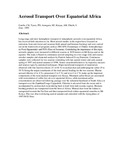| dc.contributor.author | Gatebe, CK | |
| dc.contributor.author | Tyson, PD | |
| dc.contributor.author | Annegarn, HJ | |
| dc.contributor.author | Kinyua, AM | |
| dc.contributor.author | Piketh, S | |
| dc.date.accessioned | 2015-07-14T12:14:24Z | |
| dc.date.available | 2015-07-14T12:14:24Z | |
| dc.date.issued | 1999 | |
| dc.identifier.citation | South China Sea Monsoon Experiment (SCSMEX) 1997-1998; 31 May - 4 Jun. 1999; Boston, MA; United States | en_US |
| dc.identifier.uri | http://ntrs.nasa.gov/search.jsp?R=19990087332 | |
| dc.identifier.uri | http://hdl.handle.net/11295/87685 | |
| dc.description.abstract | Long-range and inter-hemispheric transport of atmospheric aerosols over equatorial Africa has received little attention so far. Most aerosol studies in the region have focussed on emissions from rain forest and savanna (both natural and biomass burning) and were carried out in the framework of programs such as DECAFE (Dynamique et Chimie Atmospherique en Foret Equatoriale) and FOS (Fires of Savanna). Considering the importance of this topic, aerosols samples were measured in different seasons at 4420 meters on Mt Kenya and on the equator. The study is based on continuous aerosol sampling on a two stage (fine and coarse) streaker sampler and elemental analysis by Particle Induced X-ray Emission. Continuous samples were collected for two seasons coinciding with late austral winter and early austral spring of 1997 and austral summer of 1998. Source area identification is by trajectory analysis and sources types by statistical techniques. Major meridional transports of material are observed with fine-fraction silicon (31 to 68 %) in aeolian dust and anthropogenic sulfur (9 to 18 %) being the major constituents of the total aerosol loading for the two seasons. Marine aerosol chlorine (4 to 6 %), potassium (3 to 5 %) and iron (1 to 2 %) make up the important components of the total material transport over Kenya. Minimum sulfur fluxes are associated with recirculation of sulfur-free air over equatorial Africa, while maximum sulfur concentrations are observed following passage over the industrial heartland of South Africa or transport over the Zambian/Congo Copperbelt. Chlorine is advected from the ocean and is accompanied by aeolian dust recirculating back to land from mid-oceanic regions. Biomass burning products are transported from the horn of Africa. Mineral dust from the Sahara is transported towards the Far East and then transported back within equatorial easterlies to Mt Kenya. This was observed during austral summer and coincided with the dying phase of 1997/98 El Nino. | en_US |
| dc.language.iso | en | en_US |
| dc.title | Aerosol Transport Over Equatorial Africa | en_US |
| dc.type | Article | en_US |
| dc.type.material | en | en_US |

